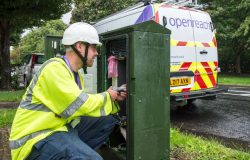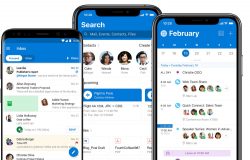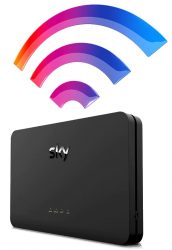It’s easy changing your broadband provider in the UK. Find out how the broadband switching process works in our step-by-step guide.
 In the UK, it’s a straightforward process changing your home broadband provider. By switching, you’ll normally be able to save money on your broadband. You may also benefit from a faster or more reliable home broadband service.
In the UK, it’s a straightforward process changing your home broadband provider. By switching, you’ll normally be able to save money on your broadband. You may also benefit from a faster or more reliable home broadband service.
In this article, we’ll explain how the broadband switching process works in the UK. This includes how your new broadband service is set up by the provider and how to change your broadband router or hub. We’ll also look at the fees that might apply for switching and how you can keep your current phone number or email address after the move.
Step-By-Step Instructions: How To Change Broadband Provider
For a step-by-step guide on how to change your home broadband provider, select your current internet provider followed by the provider you’re planning to join:
Switch Broadband Provider
Get step-by-step instructions
Contents
How Does Broadband Switching Work?
When you change your home broadband provider (and your home phone provider, if applicable), there are two key things that need to happen during the switching process:
 Your new internet service provider sets up the physical connection that provides broadband to your address. For instance, they might take over your existing phone line, or they might install a new cable or fibre optic connection. This usually happens remotely if they’re taking over an existing connection, with an engineer visit only being required to install a new connection.
Your new internet service provider sets up the physical connection that provides broadband to your address. For instance, they might take over your existing phone line, or they might install a new cable or fibre optic connection. This usually happens remotely if they’re taking over an existing connection, with an engineer visit only being required to install a new connection.- You’ll need to change your broadband router or hub. Your new broadband internet provider will give you a Wi-Fi router or hub. You’ll need to plug this in on the day of the transfer. You’ll also need to sign in to Wi-Fi again on all of your home devices as the login details will have changed.
If you’re also taking other services from your broadband provider such as TV or mobile, a separate process will apply for switching these other services. For instance, if you’re changing mobile provider, you’ll need to use the PAC Code process to move your mobile number over.
The Broadband Service Switchover
Start by ordering your broadband service from the new provider’s website.
Once you’ve done this, your new provider will begin the process of setting up a broadband connection to your address. This process usually takes around two to three weeks. Your new provider will give you a switchover date for the service, with your old broadband service continuing to work up until that date.
Switching Between Two Openreach Providers
 If you’re switching between two internet providers that use the Openreach network, there’s no need to speak to your old internet service provider (ISP). This is because your new ISP will take over the service on your existing phone line. This will automatically cancel the service with your old ISP.
If you’re switching between two internet providers that use the Openreach network, there’s no need to speak to your old internet service provider (ISP). This is because your new ISP will take over the service on your existing phone line. This will automatically cancel the service with your old ISP.
Your old broadband provider will bill you until the switchover date, with your new provider then charging you from the switchover date onwards.
ISPs using the Openreach network include:
- 1p Broadband
- BT Broadband
- Cuckoo
- EE Broadband
- John Lewis Broadband
- NOW Broadband
- Onestream
- Plusnet
- Post Office Broadband
- Shell Energy Broadband
- Sky Broadband
- TalkTalk
- Vodafone
- Zen Internet
On the day of your broadband service switchover, you’ll experience a few minutes of downtime. When this happens, you’ll need to set up the new router or hub provided by your new ISP.
Switching Between Other Providers
 If you’re switching between broadband providers that use separate physical networks, you’ll need to contact your old provider to cancel your existing service.
If you’re switching between broadband providers that use separate physical networks, you’ll need to contact your old provider to cancel your existing service.
This is because they’re not taking over the service on your existing phone line. Instead, they’re using a separate connection into your home that works independently of it. For this reason, your old broadband service will not be cancelled automatically and continues operating until you call to cancel it.
ISPs that use their own physical network include:
- Community Fibre
- Hyperoptic
- Gigaclear
- G.Network
- KCOM
- TalkTalk Ultra Fibre Optic
- Three Broadband
- Virgin Media
- Vodafone (Cityfibre)
To minimise any overlap in service, you should ask your old broadband provider to end your service around the date that your new broadband service begins. If you don’t contact your old provider to cancel your service, it’ll continue running and you’ll still be charged for it.
Changing Your Broadband Router or Hub
 In advance of your broadband switchover, you’ll be sent a broadband router or hub by your new provider. This is a small device that you’ll need to plug in inside your home.
In advance of your broadband switchover, you’ll be sent a broadband router or hub by your new provider. This is a small device that you’ll need to plug in inside your home.
The broadband router or hub creates a Wi-Fi network for your other devices to connect to, allowing them to get access to your broadband internet service. Normally, the router or hub will also have some Ethernet ports for connecting wired devices to your network and it may have a phone port for plugging in a landline telephone.
You’ll be sent one of the following routers or hubs, depending on which broadband provider you’re joining:
- If you’re joining BT Broadband, you’ll be sent the BT Smart Hub. Alternatively, you’ll get the BT Smart Hub 2 if you’re joining with Complete Wi-Fi or as a BT Halo customer.
- If you’re joining EE, you’ll get an EE Smart Hub. Alternatively, you’ll get an EE Smart Wi-Fi Router and Disc if you sign up to EE’s Smart Wi-Fi service.
- If you’re joining Plusnet, you’ll get a Plusnet Hub One router.
- If you’re joining Sky Broadband, you’ll get the Sky Broadband Hub (SR203) router.
- If you’re joining TalkTalk, you’ll get the TalkTalk Super Router when you sign up for Fast Broadband (ADSL) and the TalkTalk Wi-Fi Hub when you sign up for fibre broadband.
- If you’re joining Virgin Media, you’ll get the Hub 3 on most Virgin Media broadband plans (M500 and below). Alternatively, the new Hub 4 router is available on Virgin’s Gig1 broadband.
- If you’re joining Vodafone, you’ll get a Vodafone Wi-Fi Hub router.
You’ll be provided with step-by-step instructions on how to set up your new router or hub.
 When you install the Wi-Fi router or hub from your new broadband provider, it will come with a different network name (SSID) and password from your old Wi-Fi network. This means you’ll need to sign in again to the Wi-Fi network on all of your devices (including your laptop, tablet, smartphone, smart TV and other smart home devices). Alternatively, if it’s too much hassle to do this, you can also log in to the router and change the Wi-Fi details back to what you had before.
When you install the Wi-Fi router or hub from your new broadband provider, it will come with a different network name (SSID) and password from your old Wi-Fi network. This means you’ll need to sign in again to the Wi-Fi network on all of your devices (including your laptop, tablet, smartphone, smart TV and other smart home devices). Alternatively, if it’s too much hassle to do this, you can also log in to the router and change the Wi-Fi details back to what you had before.
If you’re using a Wi-Fi repeater or a mesh networking solution like BT Whole Home Wi-Fi or Google Nest Wi-Fi, you’ll need to set this up again to work with your new broadband router or hub.
Returning or Recycling Your Old Hub
 Once you’ve set up the broadband router or hub from your new provider, you should return or recycle the hub from your old internet service provider.
Once you’ve set up the broadband router or hub from your new provider, you should return or recycle the hub from your old internet service provider.
- If you have an old BT Broadband router, you’re encouraged to return it or recycle it. For customers who signed up to BT Broadband after the 13th December 2019, you’ll have 60 days to return your router after you cancel the service. A fee of around £50 will be charged if you fail to return it. Alternatively, if you bought your own equipment through BT’s online store, it’s yours to keep and there’s no need to return it.
- If you have an old EE broadband router, there’s no obligation to return it. However, you should ensure it’s disposed of responsibly. If you have an EE TV set-top box, this will need to be returned within 30 days or you’ll be charged £175.
- If you have an old Plusnet router, you can keep it if you like or it can be returned for free.
- If you have an old Sky Broadband router, you’ll need to return it if you have Sky Q or if you joined Sky Broadband after the 4th March 2020.
- If you have an old TalkTalk router, you can keep it if you wish or you can return it to TalkTalk.
- If you have an old Virgin Media router, you’ll need to return it after you cancel your service. A fee will be charged if you don’t do this.
- If you have an old Vodafone broadband router, you’ll need to return it if you cancel during the minimum term of your contract. A fee of £72 will be charged if you don’t do this. If you’ve completed your broadband contract, the router will belong to you and you can keep it if you wish.
Other TV & Mobile Services
 If you’re taking additional services from your broadband provider, a separate process may apply for switching those services.
If you’re taking additional services from your broadband provider, a separate process may apply for switching those services.
On some providers, the TV service is exclusive to customers who have their broadband service (e.g. BT TV and TalkTalk TV can only be used if you have the respective broadband services). On the contrary, other providers like Sky and Virgin Media will allow you to keep their TV service even when you change broadband provider.
If you’re changing TV provider at the same time as changing broadband provider, a separate installation process will apply for that service. For instance, you may need to get a dish installed if you’re signing up to Sky TV. Your new television provider will also send you a set-top box.
If you’re taking a mobile phone service from your broadband provider, this will normally be kept separate for purposes of billing and your contract. You’ll therefore be able to keep your existing mobile service but you may lose discounts and offers that are exclusive to broadband customers. If you’re changing your mobile phone provider at the same time as changing broadband provider, see our guide on how to transfer your mobile phone number.
Cancellation Fees
 Normally, your home broadband service will have a minimum initial term of either 12 months, 18 months or 24 months. This is likely the case unless you previously chose to sign up for a home broadband service with no contract.
Normally, your home broadband service will have a minimum initial term of either 12 months, 18 months or 24 months. This is likely the case unless you previously chose to sign up for a home broadband service with no contract.
If you’re still within the minimum term of your old broadband service, you might be charged an ‘early cancellation fee’ or ‘early exit fee’ by your old provider. This is charged for ending your contract early.
The following table shows how much you might need to pay for cancelling your old broadband service if you’re still within a contract:
| Internet Service Provider | Early Exit Fee |
|---|---|
| BT Broadband | 82.5% of remaining monthly charges |
| EE Broadband | Plan dependent (25-35% of remaining monthly charges) |
| Hyperoptic | Up to £20 for broadband-only, £25 for broadband and phone |
| Now Broadband | Plan dependent (£10.32 to £11.81 per remaining month) |
| Plusnet | Plan dependent (£9.63 to £12.15 per remaining month) |
| Post Office Broadband | Plan dependent (£6.19 to £20.37 per remaining month) |
| Shell Energy Broadband | £15 cease charge, plus £6.50 to £18.50 per remaining month |
| Sky | Plan dependent (£12.41 to £24.23 per remaining month) |
| TalkTalk | Plan dependent (£8.50 to £10.50 per remaining month) |
| Virgin Media | Plan dependent (£30.54 to £50.46 per remaining month) |
| Vodafone Broadband | Up to 83.3% of remaining monthly charges |
There’s more information about this in our guide on cancelling your old home broadband service.
Keeping Your Home Phone Number
 In most cases, when changing to another broadband provider, you’ll be able to keep your home phone (landline) number. This is because Ofcom (the UK’s telecommunications regulator) has number porting rules that give you the right to keep your phone number when changing provider.
In most cases, when changing to another broadband provider, you’ll be able to keep your home phone (landline) number. This is because Ofcom (the UK’s telecommunications regulator) has number porting rules that give you the right to keep your phone number when changing provider.
As long as your new provider offers a home phone/landline service, they’ll offer number portability. Simply provide your home phone number when ordering the broadband service and they’ll arrange for your phone number to be moved over.
In some cases, your new home broadband provider might not offer you a home phone service. This might be the case if you’re switching to 4G or 5G broadband, to EE’s fibre broadband service or to Virgin Media’s broadband-only service. If this applies, you’ll lose your phone number unless you first transfer it to voice-over-IP (internet-based) telephone provider.
Keeping Your E-Mail Address
 If you’re using an email address from your broadband internet provider, it will normally be closed when you change to another broadband provider. However, it might be possible to keep it in some cases:
If you’re using an email address from your broadband internet provider, it will normally be closed when you change to another broadband provider. However, it might be possible to keep it in some cases:
- If you’re using a BT Broadband email address, this will stop working 60 days after you cancel your BT Broadband service. If you’d like to keep it, you’ll need to pay for BT’s Premium Email service which costs £7.50/month for up to 11 email addresses. Email addresses provided by BT end with @btinternet.com, @btopenworld.com or @talk21.com.
- If you’re using a Plusnet email address, this will normally be cancelled along with your Plusnet broadband service. To avoid this, contact Plusnet’s customer services team before your broadband service is cancelled and ask them to leave your email account open. There’s a small monthly charge for leaving your email account open (typically in the region of £1 per month). Email addresses provided by Plusnet end with @youraccountname.plus.com.
- If you’re using a Sky email address, you can keep it at no additional cost when you cancel your home broadband service. However, you’ll need to make sure you sign in to your account at least once every six months to stop it from being deleted. Email addresses provided by Sky end in @sky.com.
- If you’re using a TalkTalk email address, this will be cancelled along your TalkTalk broadband service. If you’d like to keep it, you’ll need to subscribe to the TalkTalk Mail Plus service which costs either £5/month or £50/year. You can keep up to five email addresses active with your subscription. Email addresses provided by TalkTalk may end in @talktalk.net, @tiscali.co.uk, @lineone.net or a number of other domain names).
- If you’re using a Virgin Media email address, this will be closed 90 days after you cancel your Virgin Media broadband service. It isn’t possible to keep your email address after cancelling your service. Email addresses provided by Virgin Media may end in @virginmedia.com, @blueyonder.co.uk, @ntlworld.com or @virgin.net.
 Unfortunately, the monthly charge for keeping your email address open is fairly extortionate at some providers. This is something that Ofcom, the UK’s telecommunications regulator, is currently looking into as something that unfairly discourages people from changing their broadband provider.
Unfortunately, the monthly charge for keeping your email address open is fairly extortionate at some providers. This is something that Ofcom, the UK’s telecommunications regulator, is currently looking into as something that unfairly discourages people from changing their broadband provider.
To avoid further hassle in the future when changing your broadband provider again, we’d strongly recommend signing up for a free email provider such as Gmail or Outlook.com. As these email services are not linked to your broadband provider, it allows you to change your broadband provider again without needing to change your email address or paying to keep it open.
More Information
For further information about the broadband switching process, you can follow these step-by-step guides which walk you through the process of changing broadband provider:
- Switching Between BT & Shell Energy
- Switching Between BT & Sky
- Switching Between BT & Virgin Media
- Switching Between BT & Vodafone
- Switching Between EE & BT
- Switching Between EE & Plusnet
- Switching Between EE & TalkTalk
- Switching Between NOW & BT
- Switching Between NOW & TalkTalk
- Switching Between Plusnet & BT
- Switching Between Plusnet & Shell Energy
- Switching Between Plusnet & Sky
- Switching Between Plusnet & Virgin Media
- Switching Between Shell Energy & Sky
- Switching Between Shell Energy & Virgin Media
- Switching Between Sky & EE
- Switching Between Sky & NOW
- Switching Between Sky & TalkTalk
- Switching Between Sky & Vodafone
- Switching Between TalkTalk & BT
- Switching Between TalkTalk & Plusnet
- Switching Between TalkTalk & Shell Energy
- Switching Between TalkTalk & Vodafone
- Switching Between Virgin Media & EE
- Switching Between Virgin Media & NOW
- Switching Between Virgin Media & Sky
- Switching Between Virgin Media & TalkTalk
- Switching Between Vodafone & EE
- Switching Between Vodafone & Plusnet
- Switching Between Vodafone & Virgin Media
Alternatively, you can go to your new broadband provider’s website (BT, EE, Plusnet, Sky, TalkTalk, Virgin Media or Vodafone) for information about their broadband switching service. We’ve also got in-depth guides about broadband in the UK and how to cancel your old home broadband service.














Andy said:
VM to Plusnet: “Step 3: Plug in your Plusnet router on the go-live date”
Plug the Plusnet router into what? Don’t they need to install the thing it gets plugged into, first?
Ken replied:
Hi Andy,
Thanks for your comment. Do you have an Openreach master socket (for fibre), or an Openreach modem/ONT (for full fibre)? If not, this will be installed by an engineer during their visit to your home. You’ll then be able to plug in your Plusnet Hub router into that.
Ken
Peter Stanley said:
Does Sky use underground fibre cable or fibre via the Openreach poles? I am currently with Virgin Media.
Ken replied:
Hi Peter,
Thanks for your comment. Sky uses the Openreach network. This can be delivered either via an underground duct or an overhead pole, depending on what is normally used in your area (e.g. if your neighbours have their telephone line delivered on a pole, the fibre optic cable will also come from that pole).
Hope this helps,
Ken
Andy said:
The easy switching wasn’t so easy for me. I was out of contract and switched from TalkTalk to Vodafone, I selected keep my old number and it said they would contact TalkTalk so I didn’t have to do anything. It to the date when Vodafone installed, that went fine. I hadn’t heard anything from TalkTalk about leaving so I rang them, Vodafone hadn’t informed them but oddly now my landline number is same for Vodafone as it is for TalkTalk so how that happens who knows. Anyway, now I have to pay an extra month to TalkTalk for a notice period. So if doing a switch I would always ring your current providor and tell them you are leaving.